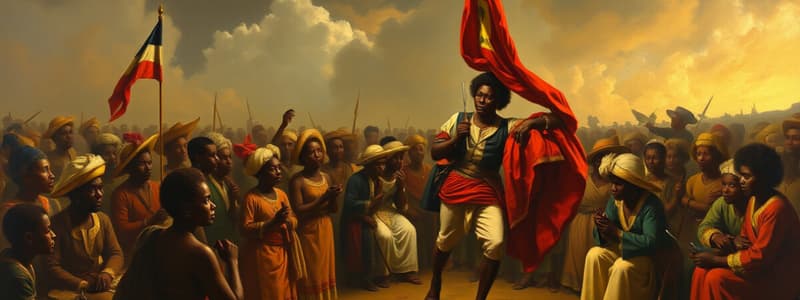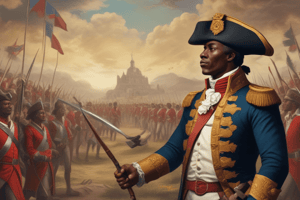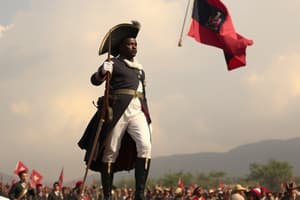Podcast
Questions and Answers
Which of these groups were part of the social structure of Saint-Domingue? (Select all that apply)
Which of these groups were part of the social structure of Saint-Domingue? (Select all that apply)
- Wealthy free colored people (correct)
- White plantation owners (correct)
- Petite blancs (correct)
- Black slaves (correct)
Who was the leader of the Haitian Revolution?
Who was the leader of the Haitian Revolution?
Toussaint L'Ouverture
What was the Declaration of Rights of Man and Citizens?
What was the Declaration of Rights of Man and Citizens?
A statement of fundamental political rights adopted by the French National Assembly.
Toussaint L'Ouverture led the slaves in war against France and won their freedom during the first phase of the revolution.
Toussaint L'Ouverture led the slaves in war against France and won their freedom during the first phase of the revolution.
What was the outcome of the second phase of the Haitian Revolution regarding independence from France?
What was the outcome of the second phase of the Haitian Revolution regarding independence from France?
What is guerilla warfare?
What is guerilla warfare?
Yellow fever is a treatable flu.
Yellow fever is a treatable flu.
When did Haiti achieve independence from colonial rule?
When did Haiti achieve independence from colonial rule?
Who took control of France in 1799 and fought in the Haitian Revolution?
Who took control of France in 1799 and fought in the Haitian Revolution?
What is sugar cane?
What is sugar cane?
Flashcards are hidden until you start studying
Study Notes
Saint-Domingue Social Structure
- Social hierarchy in Saint-Domingue included black slaves at the bottom, followed by petite blancs, wealthy free colored people, and white plantation owners at the top.
- The structure was influenced by a demand economy reflecting population dynamics and labor forces.
Toussaint L'Ouverture
- Key leader of the Haitian Revolution who played a crucial role in freeing slaves.
- Achieved significant autonomous governance for Haiti despite opposition from British and French military forces.
Declaration of the Rights of Man and Citizens
- Fundamental political rights proclaimed by the French National Assembly during the early stages of the French Revolution.
- Served as an inspiration for revolutionary movements, including Haiti's fight for independence.
Free the Slaves
- Toussaint L'Ouverture orchestrated a military campaign resulting in slave emancipation during the initial phase of the Haitian Revolution.
- Symbolized a pivotal shift in societal structure by liberating enslaved individuals.
Independence from France
- The second phase of the revolution was characterized by the struggle for complete independence from French colonial rule.
- Haitian forces, numbering 8,000, defeated an opposing French army of 40,000 using guerrilla tactics, exacerbated by outbreaks of yellow fever among French troops.
Guerrilla Warfare
- A tactical form of combat involving ambushes and surprise attacks rather than traditional open-field battles.
- Allowed Haitian forces to strategize effectively against a larger, conventional army.
Yellow Fever
- A highly fatal disease during the time, contributing significantly to the French military's casualty rates.
- Illness decimated French ranks, making them vulnerable to guerrilla attacks.
January 1, 1804
- Date when Haiti was officially declared an independent nation, making it the second country in the Americas to break free from colonial domination.
- Marked a historic moment in the global struggle for freedom and self-determination.
Napoleon Bonaparte
- Rose to power in France in 1799 and played a controversial role in the Haitian Revolution.
- Sent 40,000 troops to regain control over Saint-Domingue, employing ruthless tactics including executions and the use of aggressive animals.
Sugar Cane
- A key cash crop in Saint-Domingue that generated immense wealth for white plantation owners.
- Played an essential role in the economic interests of the colonial powers, motivating their involvement in the region.
Studying That Suits You
Use AI to generate personalized quizzes and flashcards to suit your learning preferences.




